(Click on thumbnail to download full picture)
 SETI League Photo Gallery
SETI League Photo Gallery
(Click on thumbnail to download full picture)
Attn. Journalists and Photo Editors: please check our Fair Use Policy before reproducing any of these images. Thank you.
|

|
|
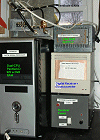
|
|
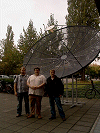
|
|
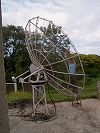
|
 |
Ken Meyer, K9KJM, has built this beautiful setup in Wisconsin. At left is the operating console, and at right the equipment rack, for Project Argus station EN64iu.
K9KJM photos |
 |
|
Argonaut Joseph Potts sends along these images of the innovative feedhorn design on his Project Argus dish. He explains, "This is a copper cylindrical
feed that I built with a movable back plate for tuning. The KEPS LNA is mounted directly on the probe inside a 'cool' box on the side of the feed. The DC cooling unit is on top of the feed. The feed is quite heavy and I had to strengthen the frame of the dish to support the feed. The feed support legs are made from fiberglass fence posts and fiberglass rake handles. These are very strong and much cheaper than prefab fiberglass rods. I left enough room for a feed choke if I decide to use one. The cooling unit keeps the LNA at 54 deg. F even in the sun. The dish is in birdbath now but is going to be moveable in Declination and will have a motorized RA movement to allow off-axis movement for signal checks."
Joe Potts photos |

|
|

|
|
 |
|
At the Bottom of the World, Robert Melville has activated his ARGUS equipment at Admussen-Scott South Pole Station. This station gives The SETI League, for the first time, full seven continent coverage. Bob does not have to worry about providing cryogenic cooling for his low noise preamplifier!
WB3EFT photo |
 |
|
In Maine, Project ARGUS station FN54gj achieved first light on 18 August 2006, with a 12 foot Paraclipse dish, and SSB Electronic low noise amplifier and downconverter, feeding an SDR-14 digital signal processor. Note that the dish is mounted close to the ground, in bird-bath mode, which allows grass to grow through the mesh.
Rick Bishop photo |
 |
|
In Michigan, member Jim Van Prooyen, N8PQK, is working on the design of a portable 21 foot diameter dish. Pictured from left to right are Tyler Van Prooyen, Jim Van Prooyen, William Van Prooyen, and Rich Nagel. The feed antenna was built by Bruce Randall, WD4JQV. This dish will be used for pulsar work in the 406 MHz band. The basic design goal is a big antenna that can be takeen to schools, parks, and star parties, to show what can be done with radio astronomy.
N8PQK photo |
 |
 |
In Sweden, the 6 foot diameter dish at Project Argus station JO89sn is getting a big brother. Greg writes, "It doesn't sound like such a big difference, but standing next to each other, the 10 footer is a monster. I'm getting eager for the first drift scan of Cygnus to compare results."
Greg Gimseus photos |
 |
 |
More images of the 3 meter dish going up in Sweden, at Project ARGUS station JO89sn. Greg says of his dish mount, "I do hope it will hold. It's about 1' diameter and 2' deep. In the bottom I weldeded a large + that I drove into the ground, to stop it from turning. The ground here is an old lake bottom. Only a few inches at the top is soil, down under we have clay, tough - hard - blue clay, almost as tough as cement itself. The dish is also in the cover of the house, so I think it'll hold. The dish is so light that one person can lift it; the mount weighs a bit more."
Greg Gimseus photos |
 |
 |
The Project Argus station of US North Central regional coordinator Don Lallier was undergoing initial testing and setup in mid April, 2006. Note his dish in bird-bath mode, solidly mounted close to the ground to survive high winds (which are ever present in Grid Square EN02vi). Don writes, "if the weather had not been so cold this winter in Nebraska, I would have had my station up a long time ago."
N0HWJ photos |
 |
|
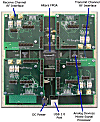
|
|

|
|

|
|

|
|
The first radio telescope in Tunisia is slowly taking shape, and it is a Project Argus station! Regional coordinator Hamdi Mani has his three-meter diameter mesh dish mounted with two 24 inch linear actuator arms for azimuth-elevation tracking, and is now working on getting the electronics installed. He writes, "a radio telescope is really a good project for high school students. I will try to convince the ministry of education of my country to include this kind of project in the schools and colleges."
Hamdi Mani photo |
 |
|
Detail of the two 24 inch linear actuator arms, used at Project Argus station JM55ht for declination and right ascension adjustment.
Hamdi Mani photo |
 |
 |
In Tunisia, Hamdi Mani sets a good example by wearing safety equipment when working on the antenna at Project Argus station JM55ht. A closeup of his hard hat (left) reveals that it sports a SETI League logo.
Hamdi Mani photos |
 |
|
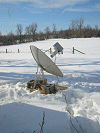
|
|

|
|

|
|
Most Project Argus stations start out when members acquire a surplus C-band satellite TV dish. This one, which seems to have fallen off its mount, is apparently no longer receiving video (or maybe the signal is just a bit snowy), so might be a good candidate for acquisition. Members have found that such derelict dishes are generally available for the asking, and can be readily repurposed into sensitive L-band radio telescopes.
Devin Bailey photo |
 |
|
Marcus Leech, VE3MDL, built a helical dish feed for 1420 MHz from exotic materials. He writes, "I combined my two hobbies, in that the form for the helix is standard paper 2.6 inch airframe tubing for high-powered model rockets. You can get this in fibreglass and a pultruded material called 'quantum tube'. It turns out that 2.65 inch OD is a near-perfect size for winding a helix with a 1420.405 Mhz center frequency. Serendipitous!"
VE3MDL photo |
 |
|
Rob Lodder, WD8BTA, built this ten-foot dish for SETI observations from Argus station EM77to in Lexington KY, USA.
SETI League photo |
 |
|
Tommy Henderson, WD5AGO, shows off two horn antennas used for radio astronomy. The larger of the two (on an az-el mount) is optimized for 1.4 GHz hydrogen line observations. Tommy is holding a smaller horn for 5.7 GHz methanol line measurements.
SETI League photo |
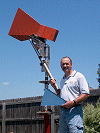 |
|
H. Paul Shuch, N6TX, uses the SETI Horn of Plenty antenna for portable operations when away from his Project Argus station FN11lh. The horn, which fits in the back of a minivan, is ideal for classroom demonstrations, exhibiting +20 dBi of gain at 1.4 GHz.
SETI League photo |
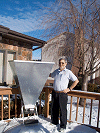 |
|
The three-meter dish at Argus station EM29je, with which Harry Kimball, N0TOU, achieved first light on 20 June 2003. Harry says, "I modified the original feed support arm to hold an RAS cylindrical feed horn and choke with an RAS LNA. It looks funny because it's hiding under the bottom 1/3 of a 20 gallon plastic trash can that is held in place with 3 large hose clamps connected end to end."
N0TOU photo |
 |
|

|
|

|
|
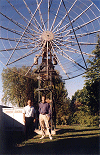
|
|

|
|

|
|

|
|
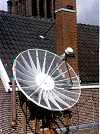
|
|
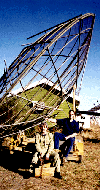 |
|
 |
|
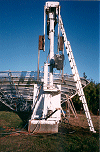 |
|
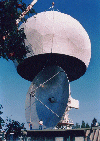 |
|  |
|
 |
|
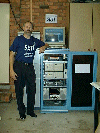 |
|
 |
 |
|  |
|
 |
|
 |
|
 |
|
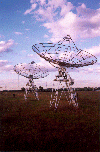 |
|
 |
|
 |
|
 |
|
 |
|
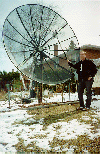 |
|
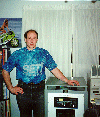 |
|
 |
|
 |
|  |
|  |
|  |
|  |
|  |
email the Webmaster | entire website copyright © The SETI League, Inc.; Maintained by Microcomm this page last updated 1 May 2010 |
Top of Page |